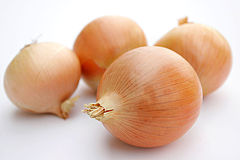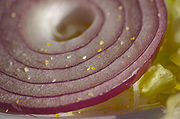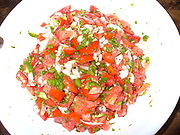
Onion
About this schools Wikipedia selection
This wikipedia selection has been chosen by volunteers helping SOS Children from Wikipedia for this Wikipedia Selection for schools. SOS Children works in 45 African countries; can you help a child in Africa?
| Onion | |
|---|---|
 |
|
| Onions | |
| Scientific classification | |
| Kingdom: | Plantae |
| Division: | Magnoliophyta |
| Class: | Liliopsida |
| Order: | Asparagales |
| Family: | Alliaceae |
| Genus: | Allium |
| Species: | A. cepa |
| Binomial name | |
| Allium cepa L. |
|
Onion is a term used for many plants in the genus Allium. They are known by the common name "onion" but, used without qualifiers, it usually refers to Allium cepa. Allium cepa is also known as the 'garden onion' or ' bulb' onion and ' shallot'.
Allium cepa is known only in cultivation, but related wild species occur in Central Asia. The most closely-related species include Allium vavilovii Popov & Vved. and Allium asarense R.M. Fritsch & Matin from Iran. However Zohary and Hopf warn that "there are doubts whether the vavilovii collections tested represent genuine wild material or only feral derivatives of the crop."
Uses
Onions, one of the oldest vegetables known to humankind, are found in a bewildering array of recipes and preparations, spanning almost the totality of the world's cultures; they are nowadays available in fresh, frozen, canned, pickled, and dehydrated forms. Onions can be used, usually chopped or sliced, in almost every type of food, including cooked foods and fresh salads, and as a spicy garnish; they are rarely eaten on their own but usually act as accompaniment to the main course. Depending on the variety, an onion can be sharp, spicy, tangy and pungent or mild and sweet.
Onions pickled in vinegar are eaten as a snack. These are often served as a side serving in fish and chip shops throughout the United Kingdom. Onions are a staple food in India, and are therefore fundamental to Indian cooking. They are commonly used as a base for curries, or made into a paste and eaten as a main course or as a side dish.
Tissue from onions is frequently used in science education to demonstrate microscope usage, because they have particularly large cells which are readily observed even at low magnifications.
Historical uses
It is thought that bulbs from the onion family have been used as a food source for millennia. In Caananite Bronze Age settlements, traces of onion remains were found alongside fig and date stones dating back to 5000 BC. Onion is native to South Asia, and is widely used in Indian cuisine. However, it is not clear if these were cultivated onions. Archaeological and literary evidence such as the Book of Numbers 11:5 suggests cultivation probably took place around two thousand years later in ancient Egypt, at the same time that leeks and garlic were cultivated. Workers who built the Egyptian pyramids may have been fed radishes and onions.
The onion is easily propagated, transported and stored. The Ancient Egyptians worshipped it, believing that its spherical shape and concentric rings symbolized eternal life. Onions were even used in Egyptian burials as evidenced by onion traces being found in the eye sockets of Ramesses IV. They believed that if buried with the dead, the strong scent of onions would bring breath back to the dead.
In ancient Greece, athletes ate large quantities of onion because it was believed that it would lighten the balance of blood. Roman gladiators were rubbed down with onion to firm up their muscles. In the Middle Ages onions were such an important food that people would pay for their rent with onions and even give them as gifts. Doctors were known to prescribe onions to facilitate bowel movements and erection, and also to relieve headaches, coughs, snakebite and hair loss. The onion was introduced to North America by Christopher Columbus on his 1492 expedition to Haiti. Onions were also prescribed by doctors in the early 1500s to help with infertility in women, and even dogs and cattle and many other household pets. However, recent evidence has proven that dogs, cats, and other animals should NOT be given onions in any form, due to toxicity during digestion.
Medicinal properties and health benefits
| Nutritional value per 100 g (3.5 oz) | |
|---|---|
| Energy | 166 kJ (40 kcal) |
| Carbohydrates | 9.34 g |
| - Sugars | 4.24 g |
| - Dietary fibre | 1.7 g |
| Fat | 0.1 g |
| - saturated | 0.042 g |
| - monounsaturated | 0.013 g |
| - polyunsaturated | 0.017 g |
| Protein | 1.1 g |
| Water | 89.11 g |
| Vitamin A equiv. | 0 μg (0%) |
| Thiamine (vit. B1) | 0.046 mg (4%) |
| Riboflavin (vit. B2) | 0.027 mg (2%) |
| Niacin (vit. B3) | 0.116 mg (1%) |
| Vitamin B6 | 0.12 mg (9%) |
| Folate (vit. B9) | 19 μg (5%) |
| Vitamin B12 | 0 μg (0%) |
| Vitamin C | 7.4 mg (9%) |
| Vitamin E | 0.02 mg (0%) |
| Vitamin K | 0.4 μg (0%) |
| Calcium | 23 mg (2%) |
| Iron | 0.21 mg (2%) |
| Magnesium | 0.129 mg (0%) |
| Phosphorus | 29 mg (4%) |
| Potassium | 146 mg (3%) |
| Sodium | 4 mg (0%) |
| Zinc | 0.17 mg (2%) |
| Percentages are relative to US recommendations for adults. Source: USDA Nutrient Database |
|
Wide-ranging claims have been made for the effectiveness of onions against conditions ranging from the common cold to heart disease, diabetes, osteoporosis, and other diseases. They contain chemical compounds believed to have anti-inflammatory, anticholesterol, anticancer, and antioxidant properties such as quercetin. However, it has not been demonstrated that increased consumption of onions is directly linked to health benefits.
In many parts of the world, onions are used to heal blisters and boils. A traditional Maltese remedy for sea urchin wounds is to tie half a baked onion to the afflicted area overnight. In the morning, the spikes will be in the onion. In the United States, products that contain onion extract are used in the treatment of topical scars; some studies have found their action to be ineffective, while others found that they may act as an anti-inflammatory or bacteriostatic and can improve collagen organization in rabbits.
Onions may be especially beneficial for women, who are at increased risk for osteoporosis as they go through menopause, by destroying osteoclasts so that they do not break down bone.
Onions and eye irritation
As onions are sliced, cells are broken, allowing enzymes called alliinases to break down amino acid sulphoxides and generate sulphenic acids. Sulphenic acids are unstable and spontaneously rearrange into a volatile gas called syn-propanethial-S-oxide. The gas diffuses through the air and eventually reaches the eye, where it reacts with the water to form a diluted solution of sulphuric acid. This acid irritates the nerve endings in the eye, making them sting. Tear glands produce tears to dilute and flush out the irritant.
Supplying ample water to the reaction while peeling onions prevents the gas from reaching the eyes. Eye irritation can, therefore, be avoided by cutting onions under running water or submerged in a basin of water. Rinsing the onion and leaving it wet while chopping may also be effective. Another way to avoid irritation is by not cutting off the root of the onion, or by doing it last, as the root of the onion has a higher concentration of enzymes. Using a sharp blade to chop onions will limit the cell damage and the release of enzymes that drive the irritation response. (Having a sharp knife and keeping the root of a halved onion on until the end also reduces the risk of cutting one's self if the knife slips). Chilling or freezing onions prevents the enzymes from activating, limiting the amount of gas generated. Having a fire, such as a candle or a burner, will help as the heat and flames will draw in the onion gas, burn it, and then send it up with the rest of the flame exhaust. In the heat, the chemical changes such that it no longer irritates the eyes. The volume of sulfenic acids released, and the irritation effect, differs among Allium species.
On January 31, 2008, the New Zealand Crop and Food institute led by Colin Eady created 'no tears' onions by using Australian gene-silencing biotechnology.
Propagation
Onions may be grown from seed or, more commonly today, from sets started from seed the previous year. Onion sets are produced by sowing seed very thickly one year, resulting in stunted plants which produce very small bulbs. These bulbs are very easy to set out and grow into mature bulbs the following year, but they have the reputation of producing a less durable bulb than onions grown directly from seed and thinned.
Seed-bearing onions are day-length sensitive; their bulbs begin growing only after the number of daylight hours has surpassed some minimal quantity. Most traditional European onions are what is referred to as "long-day" onions, producing bulbs only after 15+ hours of daylight occur. Southern European and north African varieties are often known as "intermediate day" types, requiring only 12-13 hours of daylight to stimulate bulb formation. Finally, "short-day" onions, which have been developed in more recent times, are planted in mild-winter areas in the fall and form bulbs in the early spring, requiring only 9-10 hours of sunlight to stimulate bulb formation.
Either planting method may be used to produce spring onions or green onions, which are the leaves and/or immature plants. Green onion is a name also used to refer to another species, Allium fistulosum, the Welsh onion, which is said not to produce dry bulbs.
Varieties
- Bulb onion - Grown from seed (or onion sets), bulb onions range from the pungent varieties used for dried soups and onion powder to the mild and hearty sweet onions, such as the Vidalia from Georgia or Walla Walla from Washington that can be sliced and eaten on a sandwich instead of meat.
- Multiplier onions - Raised from bulbs which produce multiple shoots, each of which forms a bulb.
- Potato onion
- Tree onion or Egyptian onion - Produce bulblets in the flower head; a hybrid of Allium cepas.
- Welsh onion or Green onion
- Leek
Shallots and ten other onion (Allium cepa L.) varieties commonly available in the United States were evaluated: Western Yellow, Northern Red, New York Bold, Western White, Peruvian Sweet, Empire Sweet, Mexico, Texas 1015, Imperial Valley Sweet, and Vidalia. In general, the most pungent onions delivered many times the benefits of their milder cousins.
Shallots have the most phenols, six times the amount found in Vidalia onion, the variety with the lowest phenolic content. Shallots also have the most antioxidant activity, followed by Western Yellow, New York Bold, Northern Red, Mexico, Empire Sweet, Western White, Peruvian Sweet, Texas 1015, Imperial Valley Sweet, and Vidalia. Western Yellow onions have the most flavonoids, eleven times the amount found in Western White, the variety with the lowest flavonoid content.
For all varieties of onions, the more phenols and flavonoids they contain, the more antioxidant and anti-cancer activity they provide. When tested against liver and colon cancer cells, Western Yellow, New York Bold and shallots were most effective in inhibiting their growth. The milder-tasting varieties—Western White, Peruvian Sweet, Empire Sweet, Mexico, Texas 1015, Imperial Valley Sweet, and Vidalia—showed little cancer-fighting ability.
Production trends
| Top Ten Onions Producers — 2005 (1000 tonnes) |
|
|---|---|
| 19,793 | |
| 5,500 | |
| 3,346 | |
| 2,220 | |
| 1,764 | |
| 1,758 | |
| 1,750 | |
| 1,637 | |
| 1,302 | |
| 1,149 | |
| World Total | 64,101 |
| Source: UN Food & Agriculture Organisation (FAO) |
|
Onions in language
In the English vernacular, "an onion" is a difficult situation, the use stemming from the onion's tendency to irritate or inflame the eyes. Conversely, the term "onion" can be used to describe any state of being, as in the phrase, "[someone] really dices my onion!" It may also represent an object of many layers. When someone is very skilled or has a great deal of knowledge about a particular subject, it is sometimes said that they "know their onions".
In some Scots dialects, onion is pronounced 'Ingin'.
An "Onion" is also an old slang term to describe a person from Bermuda; a Bermudian. Bermuda is known to sprout some of best onions in the world, that is why they're (Bermudians) called "onions".
In French, the expression "Ce n'est pas tes oignons" (That is not your onions) means that a topic is none of the listener's business.
Feminist poet Carol Ann Duffy uses the onion as a metaphor of love and relationships in her poem "Valentine" (1993), one of the poems in her collection "Mean time"
Expressions referring to "layers of the onion" evoke the process of peeling back the layers of something (a person, reality, etc.), without however reaching a core - the centre of the onion being simply another layer. The metaphor is thus used to challenge the notion that there is a core/essence 'behind' surface layers, stressing the continuity between layer and core. Due to the number of layers in an onion it can also be used simply to evoke complexity - something having 'many layers', or 'always another layer behind this one".
This idea was used (& twisted) in the first Shrek movie, ( Dreamworks LLC), when Shrek tries to explain to his partner, Donkey, that he is a complex person by telling him that 'Ogres are like onions.' (meaning that they have layers), to which Donkey replies 'Oh I get it. You leave them out in the sun too long and they go all brown and start sprouting little white hairs!'
In other languages too the onion has acquired different connotations, eg., amongst the Khasi tribe in North East India, Onion or "piat" in the local dialect refers to someone who is present everywhere or in every social gathering.
"Allium cepa"= in Romanian: "ceapă".











